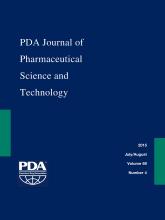Case ReportCase Studies
Reciprocal Translocation Observed in End-of-Production Cells of a Commercial CHO-Based Process
Yolande Rouiller, Beate Kleuser, Emiliano Toso, Wolf Palinksy, Mara Rossi, Paola Rossatto, Davide Barberio and Hervé Broly
PDA Journal of Pharmaceutical Science and Technology July 2015, 69 (4) 540-552; DOI: https://doi.org/10.5731/pdajpst.2015.01063
Yolande Rouiller
1Merck Serono SA, Corsier-sur-Vevey, Biotech Process Sciences, Fenil-sur-Corsier, Switzerland;
Beate Kleuser
1Merck Serono SA, Corsier-sur-Vevey, Biotech Process Sciences, Fenil-sur-Corsier, Switzerland;
Emiliano Toso
2Istituto Ricerche Biomediche Antoine Marxer RBM, Merck Group, MS-TDS-B2 Department, Colleretto Giacosa, Italy;
Wolf Palinksy
3Merck Serono SA, Global Research and Development, Coinsins, Switzerland;
Mara Rossi
4Merck Serono S.p.A., MS-TDA-P Department, Guidonia Montecelio, Italy; and
Paola Rossatto
2Istituto Ricerche Biomediche Antoine Marxer RBM, Merck Group, MS-TDS-B2 Department, Colleretto Giacosa, Italy;
Davide Barberio
5Bioclarma srl, Torino, Italy
Hervé Broly
1Merck Serono SA, Corsier-sur-Vevey, Biotech Process Sciences, Fenil-sur-Corsier, Switzerland;

References
- 1.↵
- 2.↵
- Barnes L. M.,
- Bentley C. M.,
- Dickson A. J.
- 3.↵
- Dorai H.,
- Corisdeo S.,
- Ellis D.,
- Kinney C.,
- Chomo M.,
- Hawley-Nelson P.,
- Moore G.,
- Betenbaugh M. J.,
- Ganguly S.
- 4.↵
- 5.↵
- 6.↵
- 7.↵
- 8.↵
- Jayapal K. P.,
- Wlaschin K. F.,
- Hu W. S.,
- Yap M. G. S.
- 9.↵
- Kim J. Y.,
- Kim Y. G.,
- Lee G. M.
- 10.↵
- Wurm F. M.
- 11.↵
- 12.↵
- 13.↵
- 14.↵
- Wurm F.
- 15.↵
- Derouazi M.,
- Martinet D.,
- Besuchet Schmutz N.,
- Flaction R.,
- Wicht M.,
- Bertschinger M.,
- Hacker D. L.,
- Beckmann J. S.,
- Wurm F. M.
- 16.↵
- Worton R. G.,
- Ho C. C.,
- Duff C.
- 17.↵
- Ruiz J. C.,
- Wahl G. M.
- 18.↵
- 19.↵
- 20.↵
- O'Callaghan P. M.,
- James D. C.
- 21.↵
- 22.↵
- 23.↵
- Xu X.,
- Nagarajan H.,
- Lewis N. E.,
- Pan S.,
- Cai Z.,
- Liu X.,
- Chen W.,
- Xie M.,
- Wang W.,
- Hammond S.,
- Andersen M. R.,
- Neff N.,
- Passarelli B.,
- Koh W.,
- Fan H. C.,
- Wang J.,
- Gui Y.,
- Lee K. H.,
- Betenbaugh M. J.,
- Quake S. R.,
- Famili I.,
- Palsson B. O.,
- Wang J.
- 24.↵
- 25.↵
- Brinkrolf K.,
- Rupp O.,
- Laux H.,
- Kollin F.,
- Ernst W.,
- Linke B.,
- Kofler R.,
- Romand S.,
- Hesse F.,
- Budach W. E.,
- Galosy S.,
- Müller D.,
- Noll T.,
- Wienberg J.,
- Jostock T.,
- Leonard M.,
- Grillari J.,
- Tauch A.,
- Goesmann A.,
- Helk. B.,
- Mott J. E.,
- Pühler A.,
- Borth N.
- 26.↵
- Lewis N. E.,
- Liu X.,
- Li Y.,
- Nagarajan H.,
- Yerganian G.,
- O'Brien E.,
- Bordbar A.,
- Roth A. M.,
- Rosenbloom J.,
- Bian C.,
- Xie M.,
- Chen W.,
- Li N.,
- Baycin-Hizal D.,
- Latif H.,
- Forster J.,
- Betenbaugh M. J.,
- Famili I.,
- Xu X.,
- Wang J.,
- Palsson B. O.
- 27.↵
- Hammill L.,
- Welles J.,
- Carson G. R.
- 28.↵
- Kim S. J.,
- Kim N. S.,
- Ryu C. J.,
- Hong H. J.,
- Lee G. M.
- 29.↵
- Pallavicini M. G.,
- Deteresa P. S.,
- Rosette C.,
- Gray J. W.,
- Wurm F. M.
- 30.↵
- 31.↵
- Yoshikawa T.,
- Nakanishi F.,
- Itami S.,
- Kameoka D.,
- Omasa T.,
- Katakura Y.,
- Kishimoto M.,
- Suga K. I.
- 32.↵
- Kilburn A. E.,
- Shea M. J.,
- Sargent R. G.,
- Wilson J. H.
- 33.↵
- Bolzán A. D.,
- Páez G. L.,
- Bianchi M. S.
- 34.↵
- 35.↵
- Pinkel D.,
- Straume T.,
- Gray J. W.
- 36.↵
- Ried T.,
- Schröck E.,
- Ning Y.,
- Wienberg J.
- 37.↵
- Speicher M. R.,
- Carter N. P.
- 38.↵
- Ishidate M. Jr..,
- Harnois M. C.,
- Sofuni T.
- 39.↵
- Witte I.,
- Plappert U.,
- de Wall H.,
- Hartmann A.
- 40.↵
- Flintoff W. F.,
- Livingston E.,
- Duff C.,
- Worton R. G.
In This Issue
PDA Journal of Pharmaceutical Science and Technology
Vol. 69, Issue 4
July/August 2015
Reciprocal Translocation Observed in End-of-Production Cells of a Commercial CHO-Based Process
Yolande Rouiller, Beate Kleuser, Emiliano Toso, Wolf Palinksy, Mara Rossi, Paola Rossatto, Davide Barberio, Hervé Broly
PDA Journal of Pharmaceutical Science and Technology Jul 2015, 69 (4) 540-552; DOI: 10.5731/pdajpst.2015.01063
Reciprocal Translocation Observed in End-of-Production Cells of a Commercial CHO-Based Process
Yolande Rouiller, Beate Kleuser, Emiliano Toso, Wolf Palinksy, Mara Rossi, Paola Rossatto, Davide Barberio, Hervé Broly
PDA Journal of Pharmaceutical Science and Technology Jul 2015, 69 (4) 540-552; DOI: 10.5731/pdajpst.2015.01063
Jump to section
Related Articles
- No related articles found.





